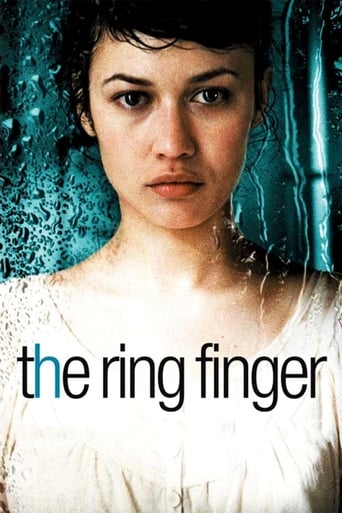christopher-underwood
Very fine film, beautifully photographed and directed with a wonderful central performance from Olga Kurylenko, who of course, has deservedly gone on to find fame and fortune, while this gem languishes, barely seen. I had never heard of it when I picked it up but am certainly glad I did. Based on a book by Japanese author Yoko Ogawa this is a marvellously quirky tale on the nature of obsession and possession. Some have mentioned David Lynch and I would have thought most of his fans would enjoy this. Set mainly in the port of Hamburg, we get a fantastic painterly picture with the increasingly strange happening inside as people visit to have painful memories preserved and thereby contained. Very Japanese in concept and this would have worked more easily in a Japanese setting but this is still a unique experience well worth seeing. Oh, and I almost forgot mesmerising score from Beth Gibbons, which is sadly not available.
gut-6
This odd but beautiful and haunting film has a mystical Japanese atmosphere in a European setting. Likewise the characters, setting and plot are all odd, beautiful, haunting and mysterious. The film seems to be about the relationship between memory and experience, and the physical objects which represent those memories and experiences.The lead character Iris starts by having a traumatic industrial accident that severs the tip of her titular ring finger, which falls into and colours a bottle of lemonade. She moves to a port city, where she time-shares a hotel room with a sailor working the night shift on the adjacent docks. They don't meet, but they "know" each other and interact through their possessions left in the hotel room, and develop a mutual but unrequited fascination for each other.Iris by chance finds a new job as a receptionist in a bizarre laboratory. The business of the laboratory is to preserve and store (i.e. embalm and inter) specimens (i.e. mementos) of painful memories, so that the owners can find closure and move on. The creepy lab director, who runs the business essentially by himself, takes an erotic interest in her, and gives her a pair of perfectly-fitting attractive red shoes that he insists she always wears.From then on, the film doesn't really develop further in terms of character or plot. This may frustrate some viewers, but it makes the film so unique and memorable. Instead it develops in bizarre and unexpected ways this theme of preserving specimens. We learn that the lab is a former girls boarding school, and that two former boarders still live in two of the few rooms not yet used as catacombs for the specimens. Both are practitioners of obsolete trades - one a pianist, the other a switchboard operator. Both are old women, yet still retain a strangely ageless girlish appearance. One has a class photo in her room from the boarding school days, which happens to show a still youthful looking lab director. Perhaps they are ex-lovers of the director. There are a couple of mild hints that the women may be ghosts. For example, one of the women suddenly appears and stares at Iris from behind while Iris explains to a potential client on the phone that specimens can't be taken of a malevolent shadow, then rapidly moves away just before Iris looks behind. An unexplained young boy also wanders the corridors, making sudden entrances and exits.Despite what Iris said, the lab makes specimens of surprising things. One client wants a specimen of a music score given by a former boyfriend - not the score itself, but the sounds. The director gets the pianist in room 209 to play the music, then places the score in a labelled plastic container, without apparently recording it.The director seduces Iris in the lab's cool inner sanctum, the boarding school's former bathing area and swimming pool, where he earlier gave her the shoes. He tells her of the girls who filled this once wet space with talk and laughter, yet it is now dry, empty and silent. Iris later dreams of herself showering among the voluble girls. Or is it a dream? One young client, who at the start of the movie had ordered a specimen of fungus growing on the ruins of her burned-down house, returns to ask for another specimen - this time the burn on her cheek. To Iris's shock, the director agrees after explaining to the client that healing a burn and taking a specimen of it are not the same thing. He takes the girl to the preserving room in the basement where Iris is not permitted, as only specimens are permitted there. The lab director does not return for the rest of the day, and a perturbed Iris repeatedly presses her ear to the basement door. Later while screwing Iris, the director asks Iris if she wants a specimen taken. Iris after some denial and hesitation suggests her mutilated ring finger.An old rasta client who works as a shoe shiner (another obsolete craft) compliments Iris's red shoes, but warns her that the red shoes are cursed, and she should not wear them too often. He invites her to visit his shoeshine stand at the station. While wandering the catacombs and looking at specimens during an idle moment, Iris sees a photo of a young girl (possibly the burn victim) also wearing the distinctive red shoes. The former switchboard operator casually mentions to Iris that Iris's predecessors in the receptionist job all suddenly disappeared without a word of warning. When Iris takes up the shoeshiner's invitation, he warns her that she should get a specimen of the shoes, as she will never be free if she doesn't take them off. Iris replies that she doesn't want to be free, to which the shoeshiner replies that he will never see her again. After returning to the lab she accidentally drops a client's mahjong set (a philosophical representation of the universe), and on the director's instruction spends the rest of the night slowly picking up the pieces and reassembling them in their rightful place. Accepting her fate, she takes off the shoes, and walks into the basement where only specimens are permitted.In concordance with the film's themes of preservation and timelessness, the film is set in the recent past, but apart from being obviously European is geographically and chronologically non-specific. The container terminal places it after the 1950's, and the lack of computers and mobiles places it before the mid-1990's, but all other markers of time and place are carefully removed.
oOgiandujaOo_and_Eddy_Merckx
A city with no name, a young woman with no history, a house apart - a strange island in a sea of trees. I like the lack of references to anything external to this system. The world of this movie is airtight. I'm reminded of the famous story retold by W. Somerset Maugham, "Appointment in Samarra", where a man, upon bumping into Death in the streets of Baghdad, flees to Samarra to avoid his wrath, but instead runs into Death who is waiting for him in Samarra, and whose anger at the jostling in Baghdad is revealed to have been mere surprise, as he had been expecting to see the man in Samarra later in the day. The sealed nature of this film demands a focus on inevitability.A young woman, Iris, wanders alone in the port area of the city, along superannuated towpaths, past the gigantic hulks of international shipping; outside of work the closest she comes to really being with others is staring at prostitutes behind plate glass, or contemplating entering a bar. There's something brutal about the isolation of Iris by the filmmaker. When I reviewed In The City of Sylvia, similarly a beautiful movie with an isolated character, I said that the filmmaker should either have won the Golden Lion at Venice or have been brutally murdered; I've similar feelings here.Today is Sunday and I've been sat in a deserted office building writing this review, ostensibly here to study for exams, but procrastinating somewhat. The morning streets are almost empty, a white contrail hints at faraway adventures that I'll never be part of, the river is full of empty boats. There is nothing good about being alone; the beauty of it is only a subtle form of cruelty.The soundtrack of the movie is done by Beth Gibbons of Portishead; its fractured entropised lilt is just right; you only ever catch fragments of lyrics.Iris gets work as the sole employee in the strange set aside laboratory. The laboratory offers a simple service whereby people may come and, for a fee, have items preserved and stored away. This seems quite a perverse thing to do. Memory, which it seems this film is about, IS perverse. Recently I wrote three poems to a woman I love, who I later learnt has no desire to be with me, I never gave them to her. A colleague tells me I should burn them, and that is perhaps the best thing to do, but perversity wills me to preserve them, to torture myself. Memory becomes viscous ooze in which you are trapped, finally it solidifies and turns into amber. People (mostly children) who can live in the moment, truly do not know how lucky they are.Some have called the film erotic, however the erotic whilst present, is as intangible as a passing cloud on a sunny day. Marc Barbé's conserver remains inscrutable and devoid of passion during sex scenes. Sex scenes with him are no more or less sensual than seeing a spider cocooning a fly, trapped for inclusion in its larder. One quite disturbing picture from above shows us an image of his head on Iris' body, he is merely consuming her.Other aspects of the erotic are fetishistic, the focus on the shoes that Iris is made to wear for her work, her clothing, which the sailor who sleeps in her room in the morning feels and smells in her absence. The movie brought to mind for me Magritte's two famous fetishistic paintings, The Red Model, and Philosophy in the Boudoir, both of which show clothing suggesting the female form. (Philosophy in the Boudoir also came to mind during In The City of Sylvia).Mahjong came into play as it does in all good surreal movies (cross-reference to Robbe-Grillet's The Blue Villa). You could if you want see Iris as a flower tile, and the laboratory door as the white dragon tile (which is a blank tile in Mahjong, or blankness with a rectangular border). These are symbolic, but I don't want to spoil the movie by mentioning how.Do not watch this movie, arrange to have all copies burnt!
enjaya
There were a lot of things I enjoyed about this movie. The cover, the synopsis and the concept were really the high points. The lead actress was quite good as well (not bad to look at too). I mean the cinematography was good I guess, but nothing to out the ordinary. I mean you can't rely on gritty filters and a softened colour palate to carry a movie. The concept for this movie really intrigued me and I had begged my friends to rent it a couple times by the cover(instead of "Poisidon" and "When a Stranger Calls"). Just it seemed to me that it was trying too hard to be something and wasn't focusing enough on characters actual motivations and any connection with the real world. "Who is this girl?" is what I'm sure would have been the question if I had convinced anyone I know to watch it with me.Don't bother. Heard its hard to find so should be a problem for most people.









